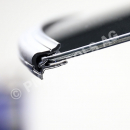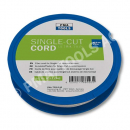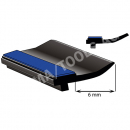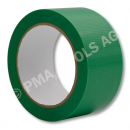Description:
For the repair of square-type gel sensors. Gel pads can easily be rebuilt with SensorTack® 2 gel and this unique refill mould.Dimensions: 57 x 40 mm
Corresponding vehicles:
CITROEN C5 (08-17) - EUROCODE: 2740
FORD C-Max/Grand C-Max (10-) - EUROCODE: 3577 (2010-2012)
FORD Fiesta VII (08-17) - EUROCODE: 3572 (2008-2011)
FORD Galaxy (06-14) - EUROCODE: 3567 only where lane departure warning system is not fitted
FORD Mondeo (07-14) - EUROCODE: 3569 only where lane departure warning system is not fitted
FORD S-Max (06-15) - EUROCODE: 3568 only where lane departure warning system is not fitted
JAGUAR XF (08-15) - EUROCODE: 4333
JAGUAR XJ (10-) - EUROCODE: 4334
JAGUAR XK (06-14) - EUROCODE: 4331 (VIN B32753 -)
LAND ROVER Discovery L319 (04-17) - EUROCODE: 7032 (03/2009-2017)
LAND ROVER Freelander II (07-14) - EUROCODE: 7038
LAND ROVER Range Rover Sport (05-13) - EUROCODE: 7036 (09/2009-2013)
PEUGEOT 3008/5008 (09-16) - EUROCODE: 6560
PEUGEOT 308 (07-13) - EUROCODE: 6554
PEUGEOT 308 CC (09-13) - EUROCODE: 6559
PEUGEOT Partner Tepee (08-18) - EUROCODE: 6558
PEUGEOT RCZ (10-) - EUROCODE: 6561
PORSCHE Cayenne (02-10) - EUROCODE: 6722
SKODA Fabia II/Roomster (07-14) - EUROCODE: 7811
SKODA Octavia II (04-13) - EUROCODE: 7810
SKODA Rapid (12-) - EUROCODE: 7815
SKODA Superb (08-15) - EUROCODE: 7812
SKODA Yeti (09-) - EUROCODE: 7813
VOLVO S60/V60 (10-18) - EUROCODE: 8841 (2010-2012)
VOLVO S80/V70/XC70 (07-16) - EUROCODE: 8836 (2007-2012)
VOLVO XC60 (08-17) - EUROCODE: 8840 (2008-2012)
VW Amarok (10-) - EUROCODE: 8609
VW Beetle (11-16) - EUROCODE: 8617
VW Caddy (04-) - EUROCODE: 8581
VW Eos (06-15) - EUROCODE: 8587
VW Golf A5 (03-08) - EUROCODE: 8568
VW Golf A6 (08-12) - EUROCODE: 8600
VW Golf Plus (05-13) - EUROCODE: 8583
VW Golf Variant/Jetta (07-13) - EUROCODE: 8586
VW Jetta (11-) - EUROCODE: 8612
VW Passat B6/B7 (05-14) - EUROCODE: 8584
VW Passat CC (08-16) - EUROCODE: 8598 (2008-02/2012)
VW Polo (09-17) - EUROCODE: 8603 (2009-2014)
VW Scirocco III (08-) - EUROCODE: 8597
VW Tiguan (07-16) - EUROCODE: 8595
VW Touareg (02-10) - EUROCODE: 8576
VW Touran (03-15) - EUROCODE: 8577
VW Transporter T5/T6 (03-) - EUROCODE: 8579 (10/2009-2015)
More information:
How do I know which sensors can be filled with SensorTack® 2 gel?
In our web shop this information is shown in the sensor article texts. Alternatively, the requested vehicle model can be chosen and the models for which SensorTack® 2 can be used are shown. Or use our SensorTack® Finder on our Webshop or Web pages to see which vehicle can be filled with SensorTack® 2.
Can other sensors be filled with SensorTack® 2?
No, only sensors for which a SensorTack® 2 refill mould is available can be filled.
How many sensors can be filled with one syringe content?
With one syringe content of SensorTack® 2, one refill mould can be filled.
What do I do with the rest of the gel in the syringe?
As one syringe of SensorTack® 2 is sufficient for one refill only, normally the whole content is used up. However, if there remains some gel in the syringe, you may dispose of it in the domestic waste.
The gel does not cure fast enough. What is the reason?
The replacing of windscreens (especially mobile fitting), is often carried out at temperatures below 23° C. As the gel cures according to the ambient temperature (cold = slowly, warm = fast), it should only be processed in areas where the temperature is at least between 10° C and 30° C maximum. However, when using our SensorTack® heating box (article no. 133601210), SensorTack® 2 can even be processed at temperatures of minus 15° C.
When has the SensorTack® 2 gel cured completely and how can I check it?
If you work with the SensorTack® heating box the curing process takes 6-8 minutes at normal ambient temperatures of 20° C. At lower ambient temperatures of below 15° C the reaction time is longer. A table detailing the curing times at different temperatures is attached on the inside of the lid of the heating box. You can test the reaction of the SensorTack® 2 gel at the edge of the sensor by carefully touching the outer gel surface with a clean object (e. g. blade of screwdriver).
Do I need the SensorTack® heating box?
We recommend using the heating box, as it does not only serve to heat up the sensor, but also to position the sensor unit completely level and protect the gel from contamination such as dirt etc.
The gel has spilled over the edge of the refill mould. Why?
This could be caused by various reasons:
The sensor was not kept level during the refilling process and the gel has spilled over the eye. We recommend our SensorTack® heating box, article no. 133601210 with built-in level indicator and fully adjustable feet.
Perhaps there was residue of old gel on the edge of the sensor as this will affect the forming of a convex shape when filling. For perfect cleaning results we recommend our SensorTack® cleaning and contact spray, article no. 13360100.
Or maybe directly after the re-filling process (before the gel could cure), the sensor was jarred or moved suddenly which could affect the surface tension of the liquid gel and thus it spilled over the eye.
I have the impression that there is too little gel in the syringe. Is that possible?
The capacity of the syringe generally ensures that there is more than sufficient gel, rather than less. Should a syringe appear to have less contents then it is likely that one, or more of the following conditions may be applicable:
The sensor to be filled is not placed on a level surface. Therefore, when filling, the gel flows to one side which will give the impression that there is not enough gel on the other side.
Expelling air bubbles from the syringe prior to use may cause additional or too much gel to be released – always ensure that you expel as little as is necessary. The syringe is not emptied completely (residues remain in th syringe).
Research and trials have shown that there is generally enough gel in the syringe to ensure a complete refill and thus a correct function of the sensor. If however the level of the gel requires additional material, it is acceptable to open a second syringe and fill the sensor up to the desired level, but this must be done within the processing time.
When installing the sensor, there are air pockets between gel and windscreen. Is that ok?
Air pockets between gel and windscreen can affect the function of the sensor. Tests have shown that this may occur when the sensor is being placed directly onto the windscreen during installation. Experience has shown that remaining air pockets will disappear normally after 1 to 30 minutes.
I see micro bubbles in the gel during or after the filling of the sensor unit. Is that ok?
Tests have shown that air bubbles can form when filling the sensor unit, if the gel is expelled too quickly from the syringe, so it is important to press out the gel slowly and evenly.
Also bubbles may form if there was air already in the syringe and this can easily be expelled by placing the syringe in a vertical position for a few minutes to allow the bubbles to rise to the top. Then with a little pressure on the plunger, you can expel the air out of the syringe through the mixer nozzle.
Air bubbles can form where the old sensor unit has been cleaned with an alcohol-based cleaner, prior to re-filling. The reason for this is that the gel can become sensitive to alcohol and we therefore recommend to wait at least 5 minutes after cleaning the sensor before starting the filling process. If possible use a cleaner free of alcohol.
High temperatures of 30° C or more during the filling process can also cause bubbles to form as the air may not have enough time to diffuse from the liquid material.
When removing the refill mould the produced gel pad lifts of the sensor. Why?
Various reasons are possible:
When removing the refill mould from the sensor unit, it is important to lift/pull the mould off as per the instructions in the packaging, otherwise the pad may be torn or become detached from the sensor.
You have not used sufficient gel grease to act as release agent in the refill mould, allowing the cured SensorTack® 2 to adhere to the mould.
The refill mould has been removed in an upward movement. After releasing the edges from the gel, the mould has to be removed in a downward movement over the sensor (please see the illustrations in the packaging).
The adjustable feet of the SensorTack® heating box fall off. Why?
The height-adjusting feet should be tightened after using the box. Otherwise they may become loose due to vibration during transport etc.
The SensorTack® heating box does not heat up. What is the reason?
When using 12 V, the cigarette lighter in some vehicles will only function with the ignition activated. We can supply an alternative adapter cable that can be connected directly to the battery, article no. 133601212.
How do I store SensorTack® 2?
SensorTack® 2 should be stored in a dry place at temperatures between 15° C and 25° C.
Does the refill have any effects on the proper functions of the rain/light sensor?
SensorTack® 2 should not affect the function of the optical unit, as the pad has been designed to OEM specifications and providing all the necessary pre-checks and procedures have been carried out, the sensor should function correctly. It is important therefore to perform a function test on the original sensor before removing the glass (by using water to test the wipers and by covering the sensor eye to check the lights), to check that all features are working correctly. If however the sensor fails to function correctly after the replacement, then it will be necessary to use specialist diagnostic equipment, to check the error and re-activate the affected function.
What are the differences between SensorTack® 1, 2, Ready+ and Ready+ Plus?
Each product has been designed to offer an individual solution for the re-use of sensors and camera units for most vehicle and installation applications.




